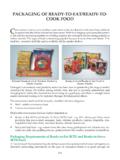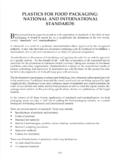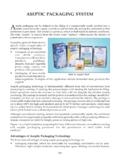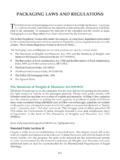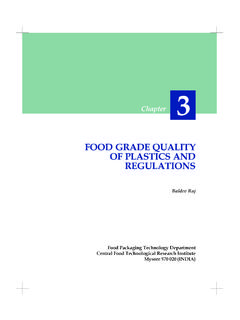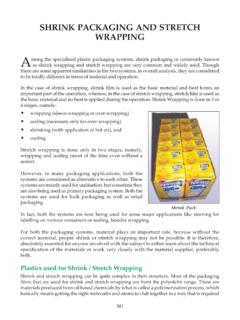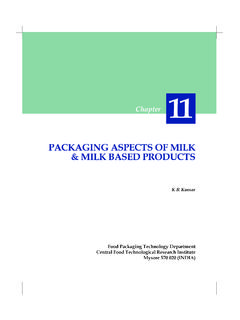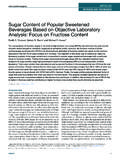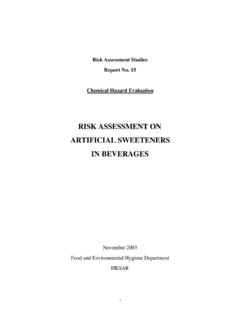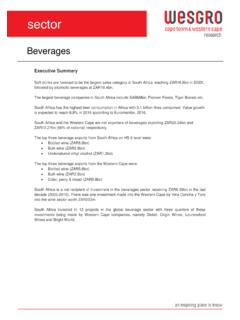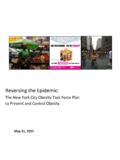Transcription of PACKAGING OF BEVERAGES - ICPE
1 PACKAGING OF BEVERAGES . T he beverage industry is one among the front-liners where massive investments are being made for expansion and technological upgradation. The PACKAGING of BEVERAGES both carbonated and non-carbonated, is a complex technological branch in the Food Processing / PACKAGING industry. The traditional returnable glass bottle has given way to newer plastic containers as well as cartons. The current trend is to improve the conventional containers, extend their share in the large market, extend the shelf-life of the products, provide greater consumer convenience and ultimately to produce economic packages. The changing Indian scenario, with implementation of various technologies and market promotion activities, has changed the scope for this industry exponentially.
2 The Indian soft drink market is worth Rs. 21,600 million a year with a growth of around 7%. The soft drinks segment is expected to grow to Rs. 1,05,000 million by the year 2005. The production of soft drinks has increased from 6230 million bottles in 1999-2000 to 6560 million bottles during the year 2001-2002. Table 1 gives the production of soft drinks. Tetrapack drinks market is currently growing at the rate of 10% with a total market share of 48%. The alcoholic BEVERAGES industry, covers Indian Made Foreign Liquors (IMFL), country liquor and beer. IMFL includes Carbonated BEVERAGES in PET Bottles wine, whisky, gin, rum, brandy and other white spirits. IMFL industry in India is roughly valued at Rs. 28,000 crores, growing at a rate of 9-10% per annum in volume terms.
3 The market size for IMFL categories in shown in Figure 1 and growth rate of IMFL categories is given in Figure 2. The Indian beer market estimated currently at Rs. 7,500 million a year has been growing at the rate of 15% per annum. 161. Table 1. Production of Soft Drinks Year Bottles( in million). 1997-1998 4920. 1998-1999 5670. 1999-2000 6230. 2000-2001 6450. 2001-2002 6600. [Source: Ministry of Food Processing Industry . Annual Report (2001-02)]. Figure 1: Market size under IMFL Category (2000 2001). Brandy White Spirts (Gin, Rum 16% Vodka & White Rum). 16% Rs 44,800 million 4%. Rs 44,800 million Rs 11,000 million Others 2%. Rs 5600 million Whisky 62% Total Value Rs 1,73600 million Rs 2,80,000 million [Source: Investment Research & Information Services Ltd.]
4 Annual Report 2001]. Figure 2: Growth Rate Of IMFL Categories (2000 2001). 25%. 20%. 15%. 10%. 5%. 0%. Whisky Brandy Rum Gin Vodka [Source: Investment Research & Information Services Ltd. Annual Report 2001]. The term beverage is derived from French word Beivre which means a drink. General meaning of a drink includes a prepared drink. 162. According to the Fruit Products Order (FPO) 1955 Act, Fruit beverage or Fruits Drink means a beverage or drink which is prepared from fruit juice and water or carbonated water and containing sugar, dextrose, invert sugar or liquid glucose. The minimum percentage of fruit juice in the final product shall not be less than 5%. Fruit syrup connotes sweetened fruit juice of not less than 25% of fruit juice.
5 Classification beverage Non alcoholic Alcoholic Non Carbonated Carbonated Fruit/sap Grain Fruit juices Soda Non Distilled Non Distilled Fruit Drinks Coca Cola distilled distilled Fruit Nectar's Tonic Water Coffee, Tea Wine Brandy Beer Whisky The PACKAGING requirements for all types of BEVERAGES are: Absolutely leak-proof and prevent contamination Protect the contents against chemical deterioration No pick up of external flavours Be hygienic and safe Retain carbonation in the case of carbonated BEVERAGES Economical, easy to use and dispose Good aesthetic appearance Product Characteristics & PACKAGING Materials for Non-Alcoholic BEVERAGES Non-alcoholic BEVERAGES are further classified into non-carbonated and carbonated drinks. Non-Carbonated Drinks Fruit BEVERAGES These include fruit juices, fruit drinks, and fruit nectars.
6 They contain fruit juice, water, sugar, dextrose, invert sugar etc. The major deterioration that occurs in fruit BEVERAGES is loss of 163. nutrition, physico-chemical changes and microbial growth. The product characteristics to be considered in relation to PACKAGING are: Acidity: All the fruit juices usually maintain an acidic character because they contain organic acids. Enzymes: Enzymes exist in all fruit juices. Sometimes they have to be destroyed and sometimes to be added. Vitamin C (ascorbic acid): The Vitamin C content of a fruit increases until just before ripening, and then decreases due to the action of an enzyme, ascorbic acid oxidase. When fruits are cooked, most of the ascorbic acid transfers from the tissue into the liquid or may be oxidized, oxidation occurring more easily in iron, copper or badly tinned vessels.
7 Losses of Vitamin C also occur during storage. Storing at low temperature, and preventing contact with air and light reduces this. Addition of sulphite has a preserving effect on Vitamin C. Colour and Flavour: They are very important, and many fruit drinks contain certain legally permitted colourings. These are added to overcome the bleaching effect of the sulphite used as a preservative, and to provide an attractive appearance. Spoilage of fruit juices is mainly due to yeast. Its growth depends upon the temperature. Spoilage of raw fruit juice at room temperature results in alcoholic fermentation, followed by the oxidation of alcohol and fruit acids by yeasts or moulds growing on the surface. Hence every living yeast cell must be removed or suppressed by pasteurization, filtration and/or preservatives.
8 Key parameters to be considered when selecting a PACKAGING system are: Process Distribution, shelf-life requirements, legislation Product composition and quality as produced and at full shelf-life Product protection required during storage, distribution and retail sale Pack size, printing options, display etc. Packing system concept, automation options, ability to integrate with existing and/or future systems Consumer appeal, image of product and packing The different PACKAGING materials used are: Glass Containers: The use of glass bottles for the PACKAGING of fruit BEVERAGES was wide- spread although the hot-fill/hold/cool process had to be applied with care to avoid breakage of the containers. Glass is still the preferred PACKAGING medium for high quality fruit BEVERAGES .
9 However, over recent years, an increasing proportion is being packed aseptically, into cartons. The improvements that have occurred in glass bottle PACKAGING are: Light weight Surface coating to increase abrasion resistance Use of wide mouth containers fitted with easy-open-caps. 164. Metal Containers: Tinplate cans made of low carbon mild steel of purity, coated with tin with easy open ends are used. These tinplate containers are either 3 piece or 2. piece containers. They are lacquered internally to prevent corrosion. Plastic Containers: Fruit juices contain organic substances, which are sensitive to bacterial contamination. PACKAGING of such products is done through hot filling, to achieve extended shelf-life, PET bottles are usually used for hot filling applications.
10 Special features are added to the containers through design and manufacturing process. The package is heat-set in order to improve the temperature resistance of the containers. PET resins with a higher Tg (glass transition) temperature and/or a faster rate of crystallisation are used. Normally hot-filled PET bottles are designed about times heavier than cold-filled bottles. Reinforcing ribs and grooves are also provided along the circumference and base of the bottle. After filling and capping operations, the liquid continues to cool, which results in formation of vacuum. The bottle wall can deform under the influence of vacuum, and this problem is overcome by providing vacuum panels in the container side wall. Generally, lower levels of PET co-polymer are preferred and intrinsic viscosities of about 80 are acceptable.

